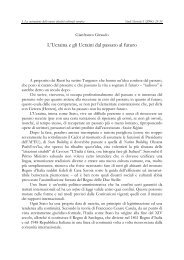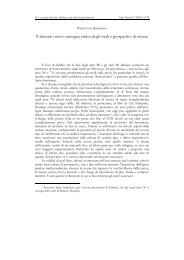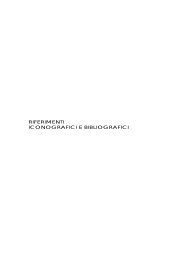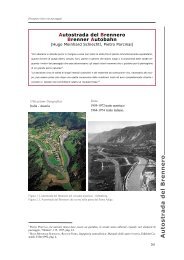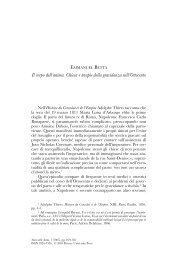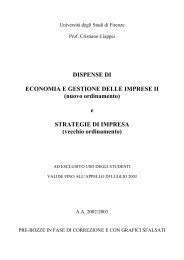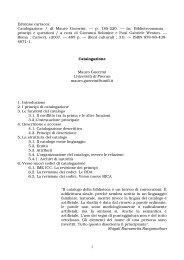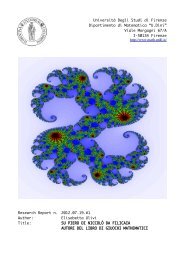Download - E-prints Archive - Home - Università degli Studi di Firenze
Download - E-prints Archive - Home - Università degli Studi di Firenze
Download - E-prints Archive - Home - Università degli Studi di Firenze
You also want an ePaper? Increase the reach of your titles
YUMPU automatically turns print PDFs into web optimized ePapers that Google loves.
Strumenti e ambienti per la formazione in rete. Prospettive, limiti e potenzialità delle tecnologie 59PARTE Seconda.Strumenti e ambienti per la formazione in rete. Prospettive, limiti e potenzialità delletecnologie3 Il ruolo <strong>degli</strong> artefatti nella formazione. Cognizione, ergonomiae <strong>di</strong>datticaStrictly speaking, nothing is a tool unless during actual use.The essence of a tool therefore, lies in something outsidethe tool itself. It is not in the head of the hammer, nor in thehandle, nor in the combination of the two that the essenceof mechanical characteristics exists, but in the recognitionof its unity and in the forces <strong>di</strong>rected through it in virtue ofthis recognition. This appears more plainly when we reflectthat a very complex machine, if intended for use by childrenwhose aim is not serious, ceases to rank in our minds as atool, and becomes a toy. It is seriousness of aim, andrecognition of suitability for the achievement of that aim,and not anything in the tool itself that makes the tool.Samuel Butler, Notebooks late 19th century 22L’utilizzo <strong>degli</strong> strumenti occupa buona parte della vita attiva <strong>degli</strong> in<strong>di</strong>vidui. Molti <strong>di</strong> questicongegni, specie quelli a base elettronica o informatica, hanno accelerato e potenziato lemodalità con cui quoti<strong>di</strong>anamente vengono svolte le operazioni, ma al contempo hannoimposto nuove abitu<strong>di</strong>ni e modalità <strong>di</strong> svolgimento delle funzioni. Le tecnologieinformatiche, in particolare, richiedono lo svolgimento <strong>di</strong> operazioni complesse attraversol’interazione con specifiche interfacce. Vengono così richieste nuove competenze cognitive especifiche abilità oculo-motorie. Ogni tecnologia rappresenta del resto qualcosa <strong>di</strong> più e <strong>di</strong><strong>di</strong>verso da una semplice risposta rivolta verso uno specifico problema.Il rapporto che si stabilisce tra uomo, tecnologia e ambiente determina infatti lo sviluppo <strong>di</strong>una vasta fenomenologia <strong>di</strong> occorrenze capaci <strong>di</strong> delineare nuove traiettorie <strong>di</strong> sviluppo <strong>degli</strong>in<strong>di</strong>vidui e della società. Cambiamenti particolarmente rilevanti, come quelli dovuti allosviluppo <strong>di</strong> alcuni nuovi me<strong>di</strong>a, comportano – a livello culturale – il riassetto dei quadripara<strong>di</strong>gmatici all’interno dei quali si delineano le <strong>di</strong>namiche <strong>di</strong> costruzione della conoscenzaumana e, conseguentemente, le prospettive <strong>di</strong> ricerca e <strong>di</strong> intervento sull’appren<strong>di</strong>mento e suiprocessi formativi. Certamente ad ogni innovazione consegue un clamore che sull’imme<strong>di</strong>atocontribuisce soprattutto alla creazione <strong>di</strong> opposte fazioni, tipicamente polarizzate tra gliestremi <strong>degli</strong> entusiasti e dei contrari, solitamente incapaci <strong>di</strong> una adeguata comprensionedelle <strong>di</strong>mensioni e della reale portata del fenomeno. In alcuni casi è solo a <strong>di</strong>stanza <strong>di</strong> tempoche si riesce a comprendere adeguatamente la conseguenza <strong>di</strong> ogni innovazione, più spessogli effetti non sono mai del tutto deco<strong>di</strong>ficabili. Nel campo dei me<strong>di</strong>a più recenti (ra<strong>di</strong>o,televisione) le ricerche avviate, e volte ad indagarne potenzialità e rischi, sono molteplici edai risultati non sempre privi <strong>di</strong> contrad<strong>di</strong>zioni. Il <strong>di</strong>battito è oggi particolarmente accesosulle ICT, information and communication technology, ed in particolare sulle tecnologie22 Citata in: Bannon, Bødker, 1991.



